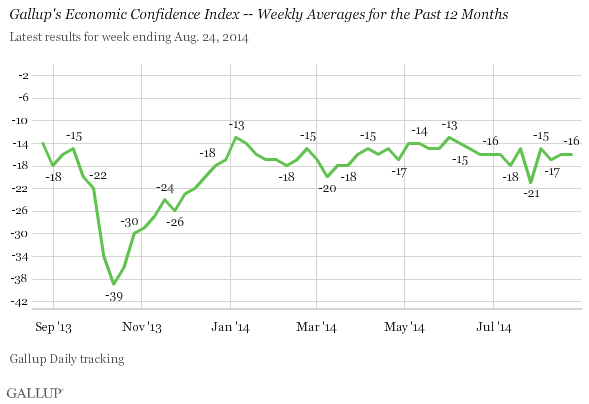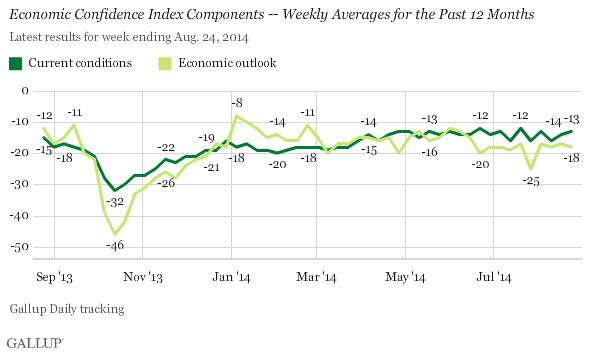WASHINGTON, D.C. -- Gallup's U.S. Economic Confidence Index continued along its static pattern, remaining at -16 for the week ending Aug. 24 -- the same score as the previous week.

Weekly index scores in July fluctuated more than those in previous months of 2014, mostly attributable to a temporary six-point drop to -21 in the middle of July, the lowest weekly score this year. But August has marked a return to relative calm; weekly scores have remained within a two-point margin for the entire month so far.
Gallup's Economic Confidence Index is the average of two components: Americans' views of the current economic situation and their perceptions about whether the economy is getting better or getting worse. The theoretical maximum score is +100, if all Americans believe the economy is "excellent" or "good" and "getting better." The theoretical minimum score is -100, if all Americans say the economy is "poor" and "getting worse."
The index components were essentially flat last week compared with the prior week, resulting in stability in the overall index. For the week ending Aug. 24, 21% of Americans rated the economy excellent (2%) or good (19%). About one in three people (34%) said it was poor. This resulted in a current conditions score of -13, just one point higher than the previous week. Meanwhile, 38% of Americans said the economy was getting better while 56% said it was getting worse, resulting in an economic outlook score of -18 -- down a point from the week before.

Bottom Line
Though July's weekly Economic Confidence Index scores were somewhat volatile, August's scores have been a return to the stability present throughout the first half of 2014.
Given that Americans' economic confidence thus far in 2014 has neither been shaken by international conflict nor boosted by positive economic signs, there is reason to believe that economic confidence is in a holding pattern that may persist for the remainder of 2014. Americans' confidence in the economy has been resilient -- perhaps because this midterm election year puts politics front and center.
Gallup.com reports results from these indexes in daily, weekly, and monthly averages and in Gallup.com stories. Complete trend data are always available to view and export in the following charts:
Daily: Employment, Economic Confidence and Job Creation, Consumer Spending
Weekly: Employment, Economic Confidence, Job Creation, Consumer Spending
Read more about Gallup's economic measures.
View our economic release schedule.
Survey Methods
Results for this Gallup poll are based on telephone interviews conducted Aug. 18-24, 2014, on the Gallup Daily tracking survey, with a random sample of 3,539 adults, aged 18 and older, living in all 50 U.S. states and the District of Columbia.
For results based on the total sample of national adults, the margin of sampling error is ±2 percentage points at the 95% confidence level.
Interviews are conducted with respondents on landline telephones and cellular phones, with interviews conducted in Spanish for respondents who are primarily Spanish-speaking. Each sample of national adults includes a minimum quota of 50% cellphone respondents and 50% landline respondents, with additional minimum quotas by time zone within region. Landline and cellular telephone numbers are selected using random-digit-dial methods. Landline respondents are chosen at random within each household on the basis of which member had the most recent birthday.
Samples are weighted to correct for unequal selection probability, nonresponse, and double coverage of landline and cell users in the two sampling frames. They are also weighted to match the national demographics of gender, age, race, Hispanic ethnicity, education, region, population density, and phone status (cellphone only/landline only/both, and cellphone mostly). Demographic weighting targets are based on the most recent Current Population Survey figures for the aged 18 and older U.S. population. Phone status targets are based on the most recent National Health Interview Survey. Population density targets are based on the most recent U.S. census. All reported margins of sampling error include the computed design effects for weighting.
In addition to sampling error, question wording and practical difficulties in conducting surveys can introduce error or bias into the findings of public opinion polls.
For more details on Gallup's polling methodology, visit www.gallup.com.
